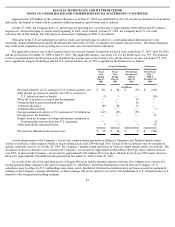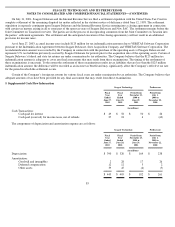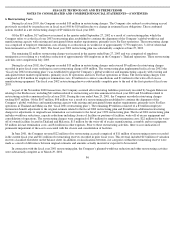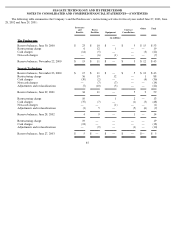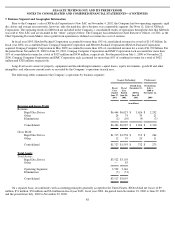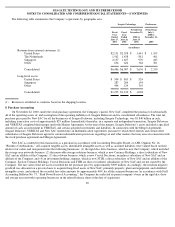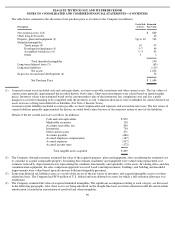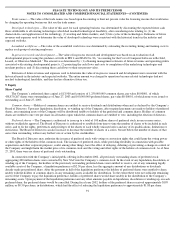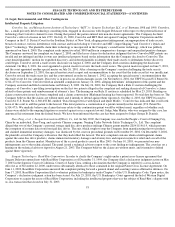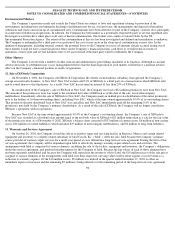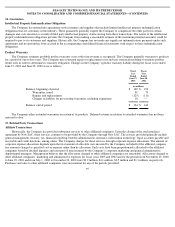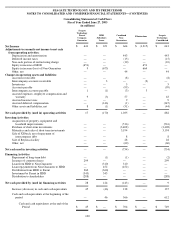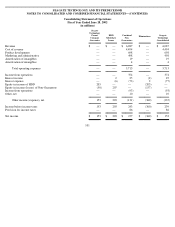Seagate 2002 Annual Report Download - page 100
Download and view the complete annual report
Please find page 100 of the 2002 Seagate annual report below. You can navigate through the pages in the report by either clicking on the pages listed below, or by using the keyword search tool below to find specific information within the annual report.
SEAGATE TECHNOLOGY AND ITS PREDECESSOR
NOTES TO CONSOLIDATED AND COMBINED FINANCIAL STATEMENTS—(CONTINUED)
11. Legal, Environmental, and Other Contingencies
Intellectual Property Litigation
Convolve, Inc. and Massachusetts Institute of Technology (“MIT”) v. Seagate Technology LLC, et al.
Between 1998 and 1999, Convolve,
Inc., a small privately held technology consulting firm, engaged in discussions with Seagate Delaware with respect to the potential license of
technology that Convolve claimed to own. During that period, the parties entered into non-disclosure agreements. The Company declined
Convolve’s offer of a license in late 1999. On July 13, 2000, Convolve and MIT filed suit against Compaq Computer Corporation and the
Company in the U.S. District Court for the Southern District of New York, alleging patent infringement, misappropriation of trade secrets,
breach of contract, tortious interference with contract and fraud relating to Convolve and MIT’s Input Shaping
®
and Convolve’s Quick and
Quiet
™
technology. The plaintiffs claim their technology is incorporated in the Company’s sound barrier technology, which was publicly
announced on June 6, 2000. The complaint seeks injunctive relief, $800 million in compensatory damages and unspecified punitive damages.
The Company answered the complaint on August 2, 2000, and filed cross-claims for declaratory judgment that two Convolve/MIT patents are
invalid and not infringed and that it owns any intellectual property based on the information that the Company disclosed to Convolve. The
court denied plaintiffs’ motion for expedited discovery, and ordered plaintiffs to identify their trade secrets to defendants before discovery
could begin. Convolve served a trade secrets disclosure on August 4, 2000, and the Company filed a motion challenging the disclosure
statement. On May 3, 2001, the court appointed a special master to review the trade secret issues. The special master resigned on June 5, 2001,
and the court appointed another special master on July 26, 2001. After a hearing on the Company’s motion challenging the trade secrets
disclosure on September 21, 2001, the special master issued a report and recommendation to the court that the trade secret list was insufficient.
Convolve revised the trade secret list, and the court entered an order on January 1, 2002, accepting the special master’s recommendation that
this trade secret list was adequate. Discovery is in process on all non-damages issues. On November 6, 2001, the USPTO issued US Patent No.
6,314,473 to Convolve. Convolve filed an amended complaint on January 16, 2002, alleging defendants’ infringement of this patent and the
Company answered and filed counterclaims on February 8, 2002. On July 26, 2002, the Company filed a Rule 11 motion challenging the
adequacy of Convolve’s pre-filing investigation on the first two patents alleged in the complaint and seeking dismissal of Convolve’s claims
related to these patents and reimbursement of attorney’s fees. The hearing on our Rule 11 motion is scheduled for May 23, 2003. Briefing on
claims construction issues has been completed and a claims construction (Markman) hearing has been requested. No trial date has been set. The
Company believes that the claims are without merit and it intends to defend against them vigorously. On May 6, 2003, the USPTO issued to
Convolve U.S. Patent No. 6,560,658 B2, entitled “Data Storage Device with Quick and Quiet Modes.” Convolve has indicated that it will seek
leave of the court to add this patent to the lawsuit. This latest patent is a continuation of a patent currently in the lawsuit (U.S. Patent No.
6,314,473). We similarly believe any claims that may relate to this continuation patent would be without merit, regardless of whether such
claims were added to the ongoing litigation or asserted against us in a separate lawsuit. Judge John Martin, who was assigned to this case, has
announced his retirement from the federal bench. We have been informed that the case has been assigned to Judge George B. Daniels.
Shao Tong, et al. v. Seagate International/(Wuxi) Co., Ltd. In July 2002, the Company was sued in the People’s Court of Nanjing City,
China by an individual, Shao Tong, and a private Chinese company, Nanjing Yisike Network Safety Technique Co., Ltd. The complaint
alleged that two of the Company’s personal storage rigid disc drive products infringe Chinese patent number ZL94111461.9, which prevents
the corruption of systems data stored on rigid disc drives. The suit, which sought to stop the Company from manufacturing the two products
and claimed immaterial monetary damages, was dismissed by the court on procedural grounds on November 29, 2002. On December 3, 2002,
the plaintiffs served the Company with notice that they had refiled the lawsuit. The new complaint contains identical infringement claims
against the same disc drive products, claims immaterial monetary damages and attorney fees and requests injunctive relief and a recall of the
products from the Chinese market. Manufacture of the accused products ceased in May 2003. On June 10, 2003, we presented our non-
infringement case to the technical panel. The panel issued a technical advisory report to the court finding no infringement. The court has set a
hearing on the technical advisory report for August 21, 2003. The Company believes the claims are without merit, and it intends to defend
against them vigorously.
Seagate Technology v. Read-Rite Corporation. In order to clarify the Company’s rights under a patent cross-license agreement that
Seagate Delaware entered into with Read-Rite Corporation as of December 31, 1994, the Company filed a declaratory judgment action on May
7, 2003 in the Superior Court of California, County of Santa Clara, seeking a declaration that the Company is entitled to a cross-license,
effective as of November 22, 2000, under terms substantially identical to those contained in the original Patent Cross License Agreement. On
June 11, 2003, Read-Rite Corporation answered the complaint putting forward a general denial and asserting various affirmative defenses. On
June 17, 2003, Read-Rite Corporation filed a voluntary petition for bankruptcy under Chapter 7 of the U.S. Bankruptcy Code. Upon notice, the
Company’s declaratory judgment action has been stayed. On July 23, 2003, the U.S. Bankruptcy Court approved the bid of Western Digital
Corporation to acquire the assets of Read-Rite Corporation, including the intellectual property that was the subject of Read-Rite’s dispute with
us, in a transaction that closed on July 31, 2003.
93



